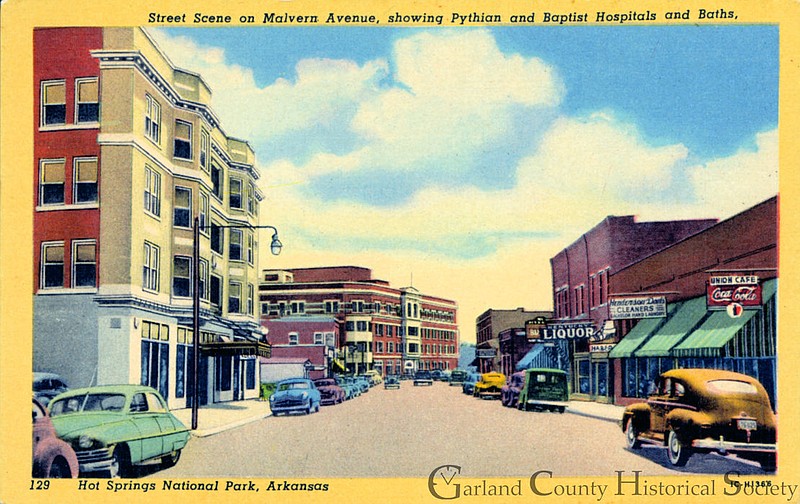Added to the National Register of Historic Places in 2003, the Pleasant Street Historic District is the largest Black historic district in Arkansas. It includes parts of Malvern Avenue, Pleasant, Church, Gulpha, Garden, Grove and Kirk streets. In addition to being a residential area, the district was the business and cultural hub of the Black community for many years, peaking in the 1920s to 1930 and again in the 1950s and 1960s.
The district is anchored on Church Street by the 1913 Gothic Revival Visitors Chapel A.M.E. Church building. Today, the buildings in the district include two churches, several commercial buildings, one community center, and many homes.
By 1915, Malvern Avenue hosted 45 businesses and the offices of Black physicians and lawyers between Church and Garden streets. Throughout the next decades, the neighborhood boasted restaurants, grocery stores, barber shops, rooming houses, and other enterprises. In clubs like the Copacabana and the Cameo or in the National Baptist Hotel, entertainers including Jack Johnson, “Peg Leg” Bates, Bill “Bo Jangles” Robinson, Louis Jourdan, Cab Calloway, Duke Ellington, Lionel Hampton, Nat King Cole, Ray Charles, and Ike and Tina Turner earned Malvern Avenue the title of “Black Broadway.”
The person most associated with the district is John L. Webb. In 1924, Webb opened the Woodmen of Union Building (now Home Harbor senior residential facility) at 501 Malvern Ave. The $500,000 building featured first-class hotel accommodations, a 2,000-seat theater, a 600-seat auditorium, a gymnasium, a print shop, a beauty parlor and a newsstand. It also housed a hospital, a nursing school, doctor and dental offices, and a bath house. The African American National Baptist Convention bought the Woodmen of Union Building in 1948. The remodeled National Baptist Hotel contained a bath house and 96 rooms and luxury suites that welcomed Black sports stars (Joe Louis, for example), entertainers, and politicians, as well as thousands of Black conventioneers.
In 1945, Webb donated a building at 433 Pleasant St. to serve the Black community with recreational, social, and educational programs. Named the Emma Elease Webb Community Center, it is still active today.
The residential streets in the district were lined with homes, often one- and two-story structures with brick veneer. The Craftsman style is most common, although there are also Victorian and Colonial Revival residences. John L. Webb’s Victorian home on Pleasant Street (covered with a brick veneer and a green tile roof in the 1920s) is a highlight. The home is being restored by P.H.O.E.B.E.
Thousands of Black convention attendees, bath house visitors, and tourists helped support Malvern Avenue as an active downtown business district through the 1950s and 1960s. However, tourism declined with the decline in the bathing industry and, in 1967, the end of gambling in the city. The end of segregation also contributed to a drop off in business at the National Baptist Hotel, which closed in 1981, and this, too, contributed to a diminishing of small, Black-owned businesses in the Malvern Avenue area.
In January 2021, the groundbreaking was held for the city’s Malvern Avenue Gateway Corridor Improvement Project. The project is improving the avenue by moving utility wires underground, and installing new street lights, street trees, bike lanes, expanded sidewalks with pavers, brick crosswalks, rain gardens, bike racks, benches, and a bus shelter. The Gateway Community Association is also greatly involved in preserving the rich heritage of the Pleasant Street Historic District.
For more information, the Garland County Historical Society may be contacted by email at [email protected], phone at 501-321-2159, or at garlandcountyhistoricalsociety.com.
Gallery: Time Tour: Pleasant Street Historic District
